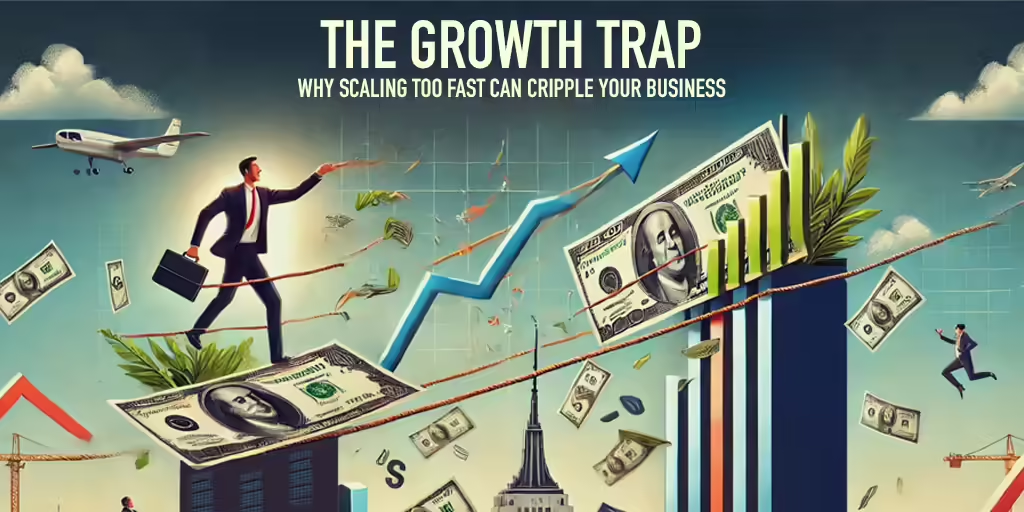

The Growth Trap: Why Scaling Too Fast Can Cripple Your Business
Posted October 2, 2024 by Kevin Chern
When it comes to business, growth often feels like the holy grail. Every entrepreneur dreams of skyrocketing sales, expanding customer bases, and opening new locations. But what if I told you that rapid growth could actually be your undoing? Scaling too fast without the right infrastructure in place is a classic mistake, and it has a name the Growth Trap. In this blog, we’ll dive deep into why scaling too fast can cripple your business and what you can do to avoid the pitfalls. Buckle up; this one’s going to get real!
What Exactly Is the Growth Trap?
The Growth Trap is what happens when businesses expand faster than they can handle, overwhelming their resources, people, and processes. Think of it like trying to sprint up a mountain without the right gear sooner or later, you’ll stumble. Rapid growth may look great on paper, but it can mask deep operational issues that rear their ugly heads when it’s too late to fix them.
Scaling isn’t just about selling more; it requires a robust strategy, adequate cash flow, and systems that can support increased demand. The keyword to remember here is “balance.” Without it, you’re setting your business up for chaos.
Red Flags: Signs You’re Scaling Too Fast
So, how do you know if your business is caught in the Growth Trap? Here are some telltale signs:
1. Cash Flow Crunches
Even profitable businesses can run out of cash when scaling too quickly. Maybe you’ve doubled your sales, but expenses like payroll, inventory, and marketing costs are eating into your reserves faster than revenue flows in. If you find yourself scrambling for loans or delaying payments, that’s a red flag.
2.Operational Chaos
Scaling fast means adding new staff, launching new products, or expanding into new markets. But if your operational systems can’t keep up, you’ll encounter breakdowns missed orders, delayed deliveries, and customer complaints will become daily battles. And let’s be honest: no one wants to field angry calls all day.
3. Employee Burnout
Growth often brings more work, and when processes aren’t streamlined, employees end up wearing too many hats. Burnout creeps in, productivity drops, and your best people may start heading for the door. Remember, it’s not just about hiring; it’s about having the right support systems in place for your team to thrive.
4. Compromised Quality
In the race to scale, quality often takes a backseat. Maybe you cut corners to meet demand or rush to release a product that isn’t fully tested. While this might deliver short-term wins, it erodes trust in the long run. Growth without quality control is a ticking time bomb.
The Hidden Costs of Scaling Too Quickly
Let’s not sugarcoat it scaling comes with costs, and not all of them are obvious. Beyond financial strain, scaling too fast can damage your brand reputation, customer relationships, and employee morale. Businesses that fail to recognize these hidden costs often find themselves backpedaling to repair the damage.
Another sneaky consequence? Market saturation. If you expand too quickly, you might flood your niche with your own products, leading to diminished demand or price wars. Suddenly, your business isn’t growing; it’s shrinking.
How to Avoid the Growth Trap
Here’s the good news: rapid growth doesn’t have to be a death sentence. With the right strategy, you can scale without falling into the Growth Trap. Here’s how:
1. Grow Smart, Not Fast
Instead of chasing rapid expansion, focus on sustainable growth. Ask yourself: “Do we have the right systems in place to handle this increase in demand?” A solid foundation will serve as a safety net when things get hectic.
2. Keep an Eye on Cash Flow
Cash is king. Forecast your expenses and keep a close watch on your cash flow. Consider setting aside a growth fund to cushion the impact of new hires, product launches, or market expansions.
3. Invest in People and Processes
Scaling means more than hiring warm bodies. Build processes that can grow with your team. Training programs, automation tools, and clear communication channels are essential. When your employees are set up for success, your business will follow suit.
4. Prioritize Customer Experience
Don’t let rapid growth compromise the customer experience. Keep the quality of your products and services high, no matter how fast you scale. Happy customers are the foundation of long-term success, and they’ll stick around if you continue to deliver value.
5. Test the Waters Before Diving In
Thinking of launching in a new market or adding a new product? Start small and scale up gradually. A pilot project can help you identify challenges and fine-tune your approach before making big investments.
Real-Life Examples of the Growth Trap
It’s not just small businesses that fall victim to the Growth Trap. Even major companies have scaled too fast and paid the price.
Remember We Work’s meteoric rise and equally fast downfall? They expanded rapidly, taking on massive real estate commitments without solidifying their business model. The result? A high-profile collapse that left employees and investors scrambling.
Or consider Starbucks’ overexpansion in the 2000s. The coffee giant opened too many stores too quickly, leading to cannibalization of their own sales. Starbucks had to close hundreds of locations to stabilize operations proving that even industry leaders aren’t immune to the Growth Trap.
Scaling at the Right Pace
The allure of rapid growth can be hard to resist. But smart business leaders know that scaling too fast can cripple a company. Instead of rushing headlong into expansion, take the time to build a solid foundation. Monitor your cash flow, support your employees, and never compromise on quality. Growth is a marathon, not a sprint pace yourself, and success will follow.
Remember, it’s not about how fast you grow it’s about how well you grow. So, slow down, take a deep breath, and build something that lasts.
Sustainable growth is the true mark of long-term business success. While the temptation to expand quickly can be strong, scaling at a manageable pace ensures your company remains resilient in the face of challenges. Every step forward should align with your strategic goals, keeping quality, financial health, and customer experience at the forefront. At the end of the day, smart growth isn’t just about seizing opportunities it’s about building a business that stands the test of time.
Tags:




